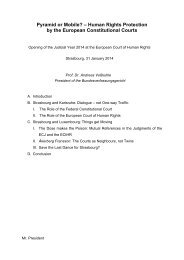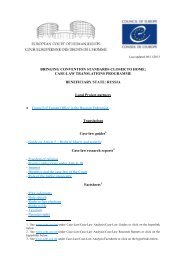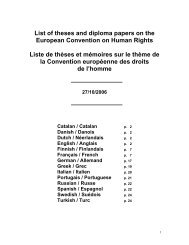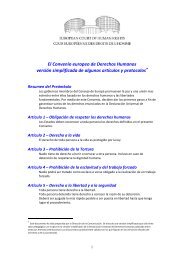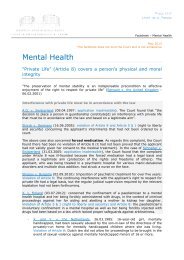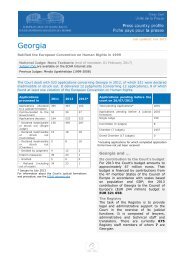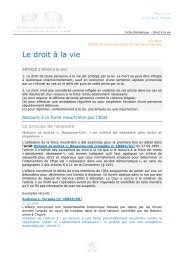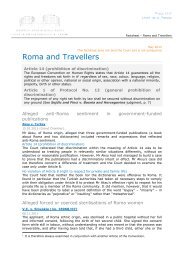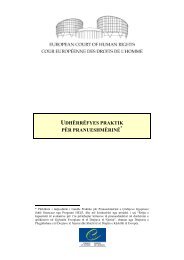The prohibition of torture - European Court of Human Rights
The prohibition of torture - European Court of Human Rights
The prohibition of torture - European Court of Human Rights
Create successful ePaper yourself
Turn your PDF publications into a flip-book with our unique Google optimized e-Paper software.
er <strong>of</strong> blows and other similar forms <strong>of</strong> <strong>torture</strong>”.<br />
<strong>The</strong> <strong>Court</strong> considered that such treatment was<br />
intentionally meted out to Mr Dikme by agents <strong>of</strong><br />
the State in the performance <strong>of</strong> their duties.<br />
Purposive<br />
<strong>The</strong> word <strong>torture</strong> is <strong>of</strong>ten used to describe inhuman<br />
treatment which has a purpose, such as the<br />
obtaining <strong>of</strong> information or confessions, or the infliction<br />
<strong>of</strong> punishment. <strong>The</strong> <strong>Court</strong> has noted on a<br />
number <strong>of</strong> occasions that the purposive element is<br />
recognised in the definition <strong>of</strong> <strong>torture</strong> in the 1987<br />
United Nations Convention, and that the definition<br />
refers to <strong>torture</strong> in terms <strong>of</strong> the intentional infliction<br />
<strong>of</strong> severe pain or suffering with the aim, inter<br />
alia, <strong>of</strong> obtaining information, inflicting punishment<br />
or intimidating. In Dikme the <strong>Court</strong> determined<br />
that the infliction <strong>of</strong> ill-treatment was<br />
carried out with the aim <strong>of</strong> extracting a confession<br />
or information about the <strong>of</strong>fences <strong>of</strong> which<br />
Mr Dikme was suspected. 22 In other cases where<br />
<strong>torture</strong> has been inflicted on detainees, the <strong>Court</strong><br />
has similarly found that the treatment was in the<br />
context <strong>of</strong> interrogation with the aim <strong>of</strong> extracting<br />
information or a confession. 23<br />
Actus reus<br />
In the first case where the <strong>Court</strong> held that there<br />
was <strong>torture</strong>, Aksoy v. Turkey, the victim had been<br />
subjected to “Palestinian hanging”, in other words,<br />
he was stripped naked, with his arms tied together<br />
behind his back, and suspended by his arms. This<br />
led to a paralysis <strong>of</strong> both arms which lasted for some<br />
time. <strong>The</strong> seriousness and cruelty <strong>of</strong> this treatment<br />
led it to be described as <strong>torture</strong> by the <strong>Court</strong>.<br />
In Aydin v. Turkey the applicant alleged, inter<br />
alia, that she was raped in police custody. <strong>The</strong><br />
<strong>Court</strong>, in finding on the evidence that she had been<br />
raped, stated that<br />
rape <strong>of</strong> a detainee by an <strong>of</strong>ficial <strong>of</strong> the State<br />
must be considered to be an especially grave<br />
and abhorrent form <strong>of</strong> ill-treatment given the<br />
ease with which the <strong>of</strong>fender can exploit the<br />
vulnerability and weakened resistance <strong>of</strong> his<br />
victim. Furthermore, rape leaves deep psychological<br />
scars on the victim which do not respond to<br />
the passage <strong>of</strong> time as quickly as other forms <strong>of</strong><br />
physical and mental violence. <strong>The</strong> applicant<br />
also experienced the acute physical pain <strong>of</strong><br />
forced penetration, which must have left her<br />
feeling debased and violated both physically<br />
and emotionally.<br />
<strong>The</strong> <strong>Court</strong> went on to hold that the rape<br />
amounted to <strong>torture</strong> in breach <strong>of</strong> Article 3 <strong>of</strong> the<br />
Convention.<br />
In Selmouni v. France the applicant was a<br />
Dutch and Moroccan national who was imprisoned<br />
in France. <strong>The</strong> applicant was subjected to<br />
22 Akkoç, op. cit., §64; Dikme,<br />
op. cit., §95.<br />
23 See Aksoy v. Turkey, judgment<br />
<strong>of</strong> 18 December 1996,<br />
ECHR 1996-VI; and Akkoç<br />
and Salman, op. cit.<br />
14



